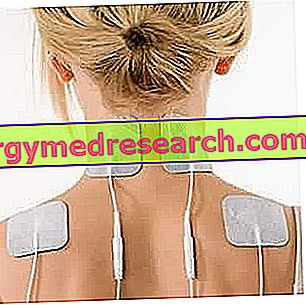Generality
TENS is the acronym of TransCutaneous Electrical Nerve Stimulation, a complementary medical technique used mainly to control some acute or chronic pain conditions.
TENS consists of the application on the skin of mild electrical impulses, which activate large diameter nerve fibers reducing the perception of pain.

So is the TENS
TENS involves the passage of low voltage electric current through the skin, in order to stimulate some specific nerve fibers. An electric generator (power supply unit or stimulator) is used to deliver painless impulses, which should be perceived by the patient as a tingling sensation. A typical TENS stimulator is able to modulate the pulse width, its frequency and intensity. Generally, the electric current is applied at high frequency (> 50 Hz), with a sensory intensity or at low frequency (<10 Hz), with an intensity that produces motor contraction. The power supply unit is connected at the skin level to the area to be treated by two or more electrodes, applied to the skin with reusable adhesive plasters. Impulses allow you to block or reduce pain signals that reach the spinal cord and brain, and can potentially alleviate muscle spasms and other painful symptoms.
Low frequencies of electric current are also used to stimulate the body to release neuropeptides and other chemical mediators (such as enkephalins, endorphins, opiates, substance P etc.), which influence the way in which the pain stimulus is perceived and transmitted.
The frequency, intensity and site of application of the treatment depend on the specific condition and the therapeutic objectives, and represent the fundamental parameters to be considered to obtain optimal effects during and after electrical stimulation. As a result, the electrodes can be placed in various regions of the body. Generally, when the power supply unit is turned on, the effects on pain are recorded approximately after about 40 minutes. Once the instrument is turned off, some people can get long lasting relief, but this result is not common. Currently, several clinical trials are aimed at demonstrating the reliability and safety of TENS. Experience has shown that this method is effective only for some patients and the therapeutic outcome depends fundamentally on the individual clinical condition. Transcutaneous electrical nerve stimulation is often used in people who cannot take pain medication because of intolerances or unwanted side effects.
An alternative application of TENS, called iontophoresis, allows the administration of a drug transcutaneously in the body: a continuous current allows the active principle to be conveyed, through the skin, only to the affected area, where it acts to reduce inflammation and produce a high analgesic effect.
Potential applications
Transcutaneous electrical nerve stimulation (TENS) is used in a variety of clinical settings to treat different conditions associated with acute and chronic pain; over the years it has become popular among both patients and healthcare professionals.
TENS has been evaluated in scientific studies for the following health problems:
- Ache. Several studies support the effectiveness of TENS for some types of pain; for this reason, it is commonly referred to as complementary physical therapy in the management of a wide range of acute or chronic conditions.
- Joint disorders. TENS can be applied to relieve various types of joint disorders, such as knee osteoarthritis, patellofemoral syndrome or temporomandibular joint pain. However, the long-term benefits are not yet clear.
- Muscle strength (physical performance). TENS is used with encouraging results also for recovery after exercise, suggesting potential benefits also in rehabilitation programs.
- Dysmenorrhea. Several studies report that TENS can reduce short-term discomfort in case of menstrual pain, decreasing the need for pain medication.
- Nervous disorders. TENS has been proposed as a treatment for nervous disorders, such as hemiplegia (paralysis on one side of the body) and spasticity in multiple sclerosis. The method is also used for neuropathic pain (neuralgia) resulting from bruxism (teeth grinding) and spinal cord injuries.
- Cardiac disorders. TENS can be used to support the treatment of some cardiovascular diseases, such as angina and cardiac ischemia. Further studies are needed before conclusions can be drawn about the effectiveness of TENS in this area; therefore, people with heart disease should consult a doctor to evaluate the possibility of benefiting from the TENS applied to their condition.
- Labor pain. The application of TENS for labor pain is controversial. Although several studies have been conducted, the results are not conclusive. In particular, it is not clear whether the passage of electric current can cause harmful effects on the fetus.
- Post-operative recovery. TENS is used for the treatment of pain after different types of surgery, including cardiac surgery and abdominal, pulmonary, gynecological and orthopedic surgery. Some studies report benefits (less pain or less need to resort to painkiller therapy), while others find no obvious improvement.
- Soft tissue injuries. TENS therapy is used to treat soft tissue injuries, such as tendonitis and tendon injuries. However, the results are variable and more research is needed.
- Alzheimer. A limited amount of research reports suggests that TENS may improve some symptoms of Alzheimer's disease, such as mood and memory.
- Autoimmune diseases. TENS can also be applied as a complementary treatment for numerous autoimmune diseases, including rheumatoid arthritis, ankylosing spondylitis and Sjögren's syndrome.
- Breathing difficulties. Some evidence suggests that TENS could be useful in case of breathing difficulties, if inserted in association with other therapies within a rehabilitation program for chronic obstructive pulmonary disease (COPD).
- Depression. Limited evidence is available that TENS can increase the effectiveness of antidepressant drugs and effectively support the treatment of depression, combined with appropriate therapies.
- Gastroparesis. A study conducted on patients with gastroparesis treated with percutaneous electrical nerve stimulation (PENS) reported positive effects. It is not clear whether these results could be found even by applying the conventional method.
- Multiple sclerosis. In a small study, patients with multiple sclerosis treated with TENS showed a tendency to improvement.
- Post-stroke rehabilitation. Some evidence demonstrates the usefulness of TENS in rehabilitation following a stroke. In particular, this technique can help improve motor function in patients.
- Attention deficit hyperactivity disorder (ADHD). One study found moderate benefit in children with ADHD.
- Tinnitus. TENS can relieve the symptoms of tinnitus (ringing in the ears), especially when tinnitus is not caused by other conditions.
- Obesity. The application of therapy to support weight loss in obese subjects has been reported. However, the evidence is limited and the effectiveness of TENS in weight loss remains unclear.
- Constipation. TENS is able to alleviate constipation without producing negative effects. However, there is limited evidence that this treatment is more effective than other therapeutic measures.
Furthermore, some scientific research suggests that transcutaneous electrical nerve stimulation (TENS) may improve the symptoms associated with:
- Pain from fractures / acute physical trauma;
- Fibromyalgia;
- Headache (migraine, cluster headache and some chronic forms);
- Backache;
- Nausea;
- Peripheral diabetic neuropathy (neuropathic pain);
- Menopause symptoms;
- Herpes zoster (post-herpetic neuralgia);
- Urinary incontinence, overactive bladder and detrusor instability;
- Circulatory disorders and low blood pressure;
- Spinal muscular atrophy;
- Claudication (pain in the legs due to an alteration in blood circulation);
- Carpal tunnel syndrome;
- Raynaud's disease;
- Gout;
- Parestetic notalgia (sensory neuropathy characterized by localized itching on the back).
Note . Based on various scientific theories, the use of TENS has been suggested for many diseases. However, there is still limited evidence about the safety or efficacy for some of these specific medical conditions. Other applications of TENS have not been sufficiently studied to draw definitive conclusions. For this series of reasons, it is advisable to consult a doctor before resorting to transcutaneous electrical nerve stimulation.
Risks and Side Effects
If your doctor or physiotherapist has confirmed the possibility of using this therapeutic option, the patient must know that TENS is well tolerated and safe. However, some patients cannot use this therapeutic option.
When you should not use TENS:
- If the cause of the pain is not known or if the diagnosis of your condition has not yet been defined;
- In the case of pacemakers or other implanted electrical devices;
- If you have epilepsy or a heart rhythm disorder;
- If you are suffering from a severe skin condition.
The most common side effects include the onset of some skin reactions, such as irritation and redness, found in about one third of people. There are isolated cases in which various other side effects are reported, including loss of sensitivity, pain or unpleasant sensations (near or far from the site of application), headache, muscle pain, nausea, agitation and dizziness. However, it is unclear whether TENS is responsible for these problems. Therapy should only be applied under medical supervision or under the close supervision of an experienced and authorized healthcare professional. With excessive or improper use, electrical burns can occur and, precisely because of this risk, TENS must be used with caution in people with reduced sensitivity, such as in patients with neuropathy.
Transcutaneous nerve electrical stimulation should not be used in patients with implanted medical devices, such as cardiac defibrillators, pacemakers, intravenous infusion pumps, etc. since they can cause interference or malfunction of the device. TENS is also contraindicated in patients with malignancy (according to some in vitro experiments electricity promotes cell growth), while it should be used with caution in pregnant women. Although several studies show that TENS can be applied to relieve pain during childbirth, the evidence about its safety is limited and the effects of electrical stimulation on the fetus are not known. In some cases, increases in fetal heart rate and interference with fetal monitoring equipment have been reported. The safety of TENS has not yet been established in children.



